The realm of photography is undergoing a significant transformation with the advent of artificial intelligence (AI). Photo AI is revolutionising how we capture, edit, and manage images, making high-quality photography accessible to everyone. This article explores the development of Photo AI, its impact on the photography industry, and the exciting advancements that lie ahead.
The Early Days of Photo AI
- Basic Enhancements: The initial stages of Photo AI focused on basic image enhancements. Simple algorithms could adjust brightness, contrast, and colour balance, improving overall photo quality with minimal user input.
- Facial Recognition: Early applications of AI in photography included facial recognition technology, which allowed for better auto-focusing and exposure adjustments, particularly in portrait photography.
- Initial Editing Tools: Basic AI-driven editing tools emerged, offering automated cropping, red-eye removal, and simple retouching options.
Major Milestones in Photo AI Development
- Deep Learning and Neural Networks: The introduction of deep learning and neural networks marked a significant milestone in Photo AI. These technologies enabled more complex image analysis and processing, leading to more sophisticated enhancements and editing capabilities.
- Object Detection and Segmentation: AI advancements allowed for accurate object detection and segmentation within images. This enabled features such as background removal, selective adjustments, and more precise edits.
- Style Transfer and Artistic Filters: AI began to enable style transfer, allowing users to apply artistic filters that mimic the styles of famous artists or specific visual aesthetics. This added a creative dimension to photo editing.
Current State of Photo AI
- Advanced Editing Tools: Today, Photo AI offers a wide range of advanced editing tools. These include automated retouching, noise reduction, sharpening, and even complex manipulations like sky replacement or virtual makeup application.
- Real-Time Enhancements: Modern cameras and smartphones equipped with AI can perform real-time enhancements as photos are taken. This includes dynamic adjustments to exposure, focus, and colour, ensuring optimal results instantly.
- Smart Photo Management: AI-powered photo management tools can organise, tag, and sort large collections of images. Features like facial recognition and scene detection make it easier to find and manage photos.
Key Technologies Driving Photo AI
- Machine Learning: Machine learning algorithms enable Photo AI to learn from vast datasets, improving its ability to recognise patterns and make accurate adjustments.
- Computer Vision: This field of AI focuses on enabling machines to interpret and understand visual information. Computer vision technologies are crucial for tasks like object detection, facial recognition, and scene analysis.
- Generative Adversarial Networks (GANs): GANs are used to generate new images or enhance existing ones by learning from a set of training images. They play a significant role in tasks like image upscaling and style transfer.
Future Developments in Photo AI
- Enhanced Personalisation: Future Photo AI tools will offer even more personalised enhancements, learning from individual user preferences to provide tailored suggestions and adjustments.
- Integration with Augmented Reality (AR): AI will further integrate with AR, enabling real-time overlays and interactive elements in photography. This could revolutionise how we capture and experience photos.
- Automated Content Creation: AI will continue to advance in generating content, including fully automated photo shoots, virtual environments, and synthetic images that blend seamlessly with real-world photos.
- Ethical and Privacy Considerations: As Photo AI evolves, addressing ethical concerns and ensuring data privacy will be paramount. Transparent AI models and secure data handling practices will be essential.
Impact on the Photography Industry
- Democratisation of Photography: Photo AI has made high-quality photography accessible to amateurs and professionals alike. Advanced tools that were once exclusive to experts are now available to anyone with a smartphone.
- New Creative Possibilities: AI-driven tools have expanded the creative possibilities in photography, enabling artists to experiment with new styles and techniques.
- Efficiency and Productivity: AI has streamlined many aspects of photo editing and management, allowing photographers to focus more on their creative vision and less on tedious tasks.
Conclusion
The development of Photo AI has significantly transformed the photography landscape, offering powerful tools that enhance creativity, efficiency, and accessibility. As AI technology continues to evolve, we can expect even more exciting advancements that will further revolutionise the way we capture, edit, and experience photos. Embracing these innovations will enable photographers of all levels to push the boundaries of their craft and explore new creative horizons.



